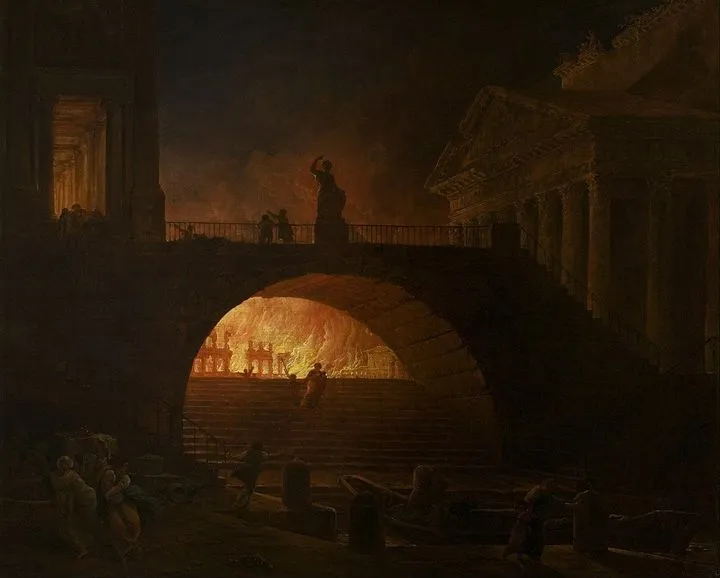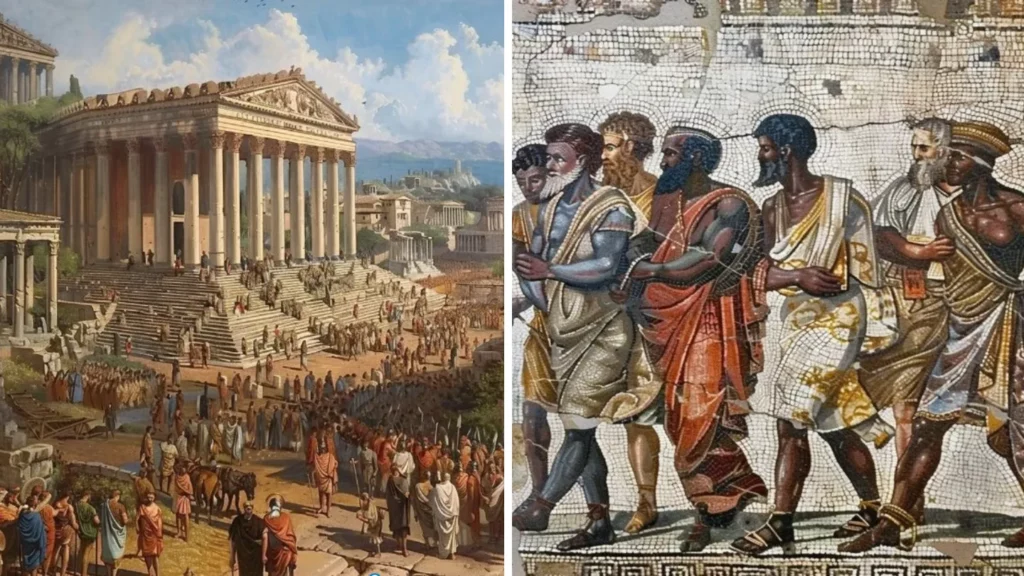When we think of ancient Rome, Julius Caesar, the Colosseum, and gladiators come to mind. There’s no denying that the Roman Empire, which spanned from 753 BC to 476 AD, was an iconic era of ancient history. Ancient Rome’s influence can be seen across many centuries, even shaping the Western world today.
From pet lions to violent chariot races, Roman society was full of surprises. Prepare to throw out everything you thought you knew about ancient Rome because we’re about to reveal what life was really like.
Gladiators Were Trained to Die
The life of a gladiator revolved around entertaining crowds and emerging victorious. Gladiatorial combat was as much about the spectacle as it was about survival, so gladiators were trained not only in combat skills, but also in the fine art of delivering and receiving the fatal blow.

While not all fights resulted in death, some gladiators did lose their lives in the arena. As the popularity of gladiator fighting grew throughout the Roman period, the fights became more brutal. In the 3rd Century, the mortality rate was around 25% of gladiator fighters.
Slaves Could Buy Their Freedom
Slavery had a long and complicated history in the ancient world. One way that Roman slavery differed from other cultures was that they had the concept of Manumission—meaning slaves were able to be freed.

Some Roman slave owners just freed their slaves outright, while others allowed them to pay for their own freedom using any money they’d saved as gifts. The prospect of potential freedom encouraged slaves to be hardworking and obedient, but the process was complicated. Some slaves never earned enough to buy their freedom and some after being freed still found the stigma of slavery hard to overcome.
Romans Had Short Work Days
In Rome, the workday was all about productivity and leisure in equal measure. With no clocks, Romans relied on the sun to wake them up around 6 a.m. They’d eat breakfast and then get right to work until the early afternoon—then it was time to relax.

Only a few stores would stay open past the early afternoon hours, as most people were busy watching gladiator competitions, chariot races, and wrestling matches, or visiting the baths or the theater. Most taverns stayed open all day as social hubs for eating and drinking.
Fires Were Extremely Common
People in ancient Rome didn’t have access to the same building materials we have today. Roman insulation was made from wood and mud, meaning they were susceptible both to crumbling down, and catching on fire.

Thanks to the densely populated and tightly packed nature of the city, fires were a constant threat, and they weren’t helped by Romans using hot coals and open flames to cook food in their homes. One of the most infamous was the Great Fire of Rome in 64 AD, which raged for six days and seven nights, destroying much of the city.
Banquets Followed the Same Format
For the wealthiest folk living in ancient Rome, simply hosting a banquet wasn’t enough. Banquets were about so much more than just eating and drinking—they were also important social and political events, where guests could network, form alliances, and display their wealth and status.

Each banquet usually followed the same extravagant format. Guests reclined on couches while dining, beginning with appetizers, then a main course, followed by entertainment from acrobats and musical performers. Sometimes, the chefs would even sing as they served their food. If the host was particularly wealthy, it wasn’t uncommon for live lions and bears to make an appearance.
The Ancient Mountain Made of Pots
Olive oil was a huge deal in ancient Rome. The Romans imported it from across the world, to be used at the baths, in medicine, and more. They consumed such a vast quantity of oil that they soon found themselves overwhelmed with a mass of empty terracotta containers, and nothing to do with them.

These broken pots were discarded after use because the oil residue would turn rancid, making them unsuitable for reuse. Over time, these discarded pots accumulated into a massive artificial mound that still exists today on Monte Testaccio, also known as “Potsherd Mountain”.
Emperors Owned Wild Animals
There are strange and eccentric emperors dotted throughout Roman History. With all the power and the support from the public, they were free to flaunt their wealth and put all kinds of unusual laws into action.

Emperor Elagabalus was one of the more eccentric rulers of Rome. He was just a teenager when he started his reign and was known for his scandalous parties, disregarding all the traditional Roman customs. Like many other emperors, he owned wild animals including lions and bears, which he allowed to roam freely around his parties.
Baking Was a Lucrative Job
In Roman times, grain was a form of currency, but there’s not much you can do with grain apart from baking it into bread. Most Romans didn’t have ovens in their homes, which meant that bakers played an incredibly important role in society.

Being a bread baker in ancient Rome was not only a prestigious role, but a lucrative one, too. The men who controlled the bread and commercial ovens were well-liked and respected. They often ran for political office and influenced civic elections.
Gladiators’ Armor Was Only for Show
If you thought there was only one type of gladiator in ancient Roman times, you’d be sorely mistaken. It’s estimated that there were actually more than 24 types, each with their own armor and weapons to use in the arena. It might have looked impressive, but it was mostly for show.

The armor wasn’t based on actual armor used on the battlefield. While some gladiators wore full suits of armor, others wore minimal protection to allow for greater mobility while fighting. It was designed to keep things fair and make it more entertaining for the audience.
There Were No Trained Doctors or Hospitals
Anyone who needed serious medical attention in ancient Rome was just about out of luck. Back then, there was no such thing as a trained doctor, and the closest thing to a hospital was a tent on the battlefield where soldiers would go to rest.

Roman residents instead had to rely on self-proclaimed doctors, a title that anyone could adopt without any formal qualifications. Success was often measured by the ability to keep patients alive rather than by advanced medical knowledge. Since autopsies were not allowed in Rome, people knew very little about the inside of the human body.
Justice Was Based on Social Status
In ancient Rome, justice was heavily influenced by social status. There was no police force, but this didn’t mean people acted without restraint. If someone caused another’s death, it was down to the victim’s family to seek justice, usually resulting in the offender’s death, unless they were of higher social status.

The judicial system was eventually established later, allowing accusations against higher-ups, but wealth often swayed the outcome. The elite usually got off lightly with lenient punishments, thanks to their perceived contributions to society, while people of lower status were left with harsh punishment. This system ensured a sense of social order, but still favored the powerful.
Branding Started in Rome
These days, it’s pretty common to put your name on something you’ve made. It turns out that this practice is nothing new—people in Rome were branding their items before selling them. Everything from bread to pottery to glassware was branded.

One of the most famous examples was Aulus Umbricius Scaurus, the Pompeii citizen labeled as a legendary fish sauce producer. He was so good at marketing and branding his name on mosaics, pottery, and fish sauce bottles that Aulus Umbricius Scaurus appeared on about 29% of fish sauce containers in Pompeii.
Rome Was Covered in Billboard Advertising
These days, it’s common for companies to spend millions of dollars on their advertising budget, especially for major events like the Super Bowl. But did you know that this was happening all the way back in ancient Rome?

The Roman Games were a major event across the city, and you might be surprised to learn how much they were advertised. Emperors would commission huge murals on walls, people would graffiti portraits of specific gladiators, and handouts were distributed on the streets to convince people to attend. Emperor Augustus even once used live crocodiles to advertise his games.
Worshipping the Many Gods
The Roman Empire was a polytheistic civilization, meaning they recognized and worshiped multiple gods and goddesses—at least 67, to be precise. That’s not even including all the demigods!

Jupiter, Juno, and Minerva were among the main deities, and since people in ancient Rome believed that everything was protected and governed by spirits, including rivers, trees, and their homes, they often built shrines for them. These weren’t just for worship, but also as a way to show off their wealth. The more impressive your shrine, the wealthier you were in Roman society.
One Goddess Had Her Own Cult
Ancient Romans borrowed deities from all kinds of cultures, and one of the most culturally significant was Cybele. Also known as Magna Mater (Great Mother), Cybele was a Phrygian goddess who symbolized fertility, motherhood, and the earth. She even had her own cult of followers with some interesting rituals.

The worship of Cybele involved ecstatic ceremonies, with the males devoting themselves to her service through castration. The cult of Cybele was officially recognized by the Roman Senate in 204 BC, and the annual festival in her honor, known as the Megalesia, became one of the most important religious festivals in Rome.
Octopus Was the First Urban Legend
If stories from ancient Rome are anything to go by, urban legends are not a modern creation. Aelian, a writer from the 3rd century AD, was one of the first people to document what’s considered one of the first urban legends, the story of a giant octopus who terrorized the city of Puteoli.

According to the legend, the octopus grew tired of its sea diet and ventured into the city through the sewer system to feast on pickled fish in a merchant’s shop. The creature was so large that it took a group effort to capture or kill it.
Female Slaves had a Tough Time
In ancient Rome, female slaves led harsh and often brutal lives, with little control over their fates. They were considered property and could be bought, sold, or punished at their owners’ will.

Some female slaves were used as domestic servants, while others were forced into more personal roles, including being concubines or entertainers. These women often had to endure grueling work and mistreatment, but a few managed to earn their freedom or gain influence within the household through cunning and resilience.
Cold Plunging is Nothing New
In Ancient Rome, bathhouses were not just for relaxation but also for fitness. Many thermae featured palaestrae, or exercise areas, where patrons could engage in various physical activities before their bath.

The fitness regimens included wrestling, weight lifting, and ball games, which helped maintain physical prowess. Bathers would work up a sweat and then enjoy the caldarium (hot bath), tepidarium (warm bath), and frigidarium (cold plunge) to relax and cleanse themselves, as a solo activity or with their Roman friends.
Praying Looked Very Different
In ancient Rome, religion played a significant role in daily life, with people often praying to the spirits around them. Since the gender of these spirits was often unknown, they would address them as “god or goddess” to avoid offending them because getting their gender wrong could have meant they were ignored.

Romans sought to cover all bases and find loopholes in their religious practices to ensure their prayers were heard. Rituals and sacrifices were common ways to appease these spirits, such as farmers sacrificing a pig before plowing the land. This practice was believed to make up for disturbing the ground.
Baths Were Mostly Men-Only Zones
While some Roman bathhouses had designated times or separate facilities for women, they were generally restricted from the largest and most elaborate baths, which were primarily male-only domains. This exclusion was largely due to the Roman social structure and moral codes, which prioritized modesty and controlled interactions between genders.

Additionally, Roman men viewed the baths as vital spaces for social, political, and business networking, spheres from which women were often excluded. Despite clean facilities for women, cultural norms significantly limited their access and participation in these central communal activities.
It Paid to Be a Chariot Racer
Did you know that most chariot racers in ancient Rome were slaves? Chariot racing was a lucrative business, especially for the racers themselves. That’s why many slaves eagerly participated despite the danger because victory meant a big share of the winnings.

Betting on chariot races was also a popular practice. Some racers would even bet on themselves so they could walk away with substantial earnings. And in case you were wondering, there was no loyalty, either. Drivers frequently switched teams to join the most successful ones—white and red.
Slaves Wore Plaques as Punishment
In ancient Rome, slaves who attempted to escape or displayed misconduct were often punished by being forced to wear a “furca” or a plaque around their necks. This plaque, called a “titulus,” would typically bear inscriptions detailing the slave’s name, offense, and contact information for their owner, effectively serving as a form of public humiliation and deterrence against further disobedience.

These plaques not only signified the slave’s status but also made their capture and return easier if they attempted to escape again, reinforcing the control exerted by slave owners.
Was the “Thumbs-Down” From “Gladiator” Real?
The epic movie Gladiator saw ancient Rome brought back to life on the big screen. One of the most iconic scenes is when the emperor decides the gladiators’ fate with a thumb facing up or down. But did that really happen in the stadiums of Rome?

There’s been extensive debate about what the precise gestures really meant or whether the judges really used their thumbs in the first place. Some historians suggest the opposite to the movie, that a “thumbs down” signified the losing gladiator was to be spared while the “thumbs up” meant he was to be killed.
Emperors Mingled at the Baths
Using public baths was an everyday experience for the Romans, and it didn’t take them long to become breeding grounds for illnesses. However, this did not stop emperors from showing up to the baths like local celebrities, to mingle with the public and help their public campaign.

While regular plebeians resorted to rubbing against stone walls or applying oil to exfoliate at the baths, the emperors enjoyed the luxury of having an entourage to cater to their every need. These people were responsible for carrying their robes, rubbing oil on the emperor’s skin, and using a tool called a strigil to scrape it all off.
Marble Heads Without Bodies
Anyone who’s been to a museum will have seen plenty of sculptures depicting prominent figures from the ancient Roman era. Have you ever wondered why many of the marble heads of Roman senators, philosophers, and emperors are missing their bodies?

This strange phenomenon is because crafting full marble statues was so time-consuming. The life span and reign of some emperors were so short that they’d die before the artist was finished sculpting the entire body. It was far more efficient to create detachable heads, allowing for interchanging heads on a single body.
Inflation Caused Financial Strain
Inflation has been a social concern ever since the days of ancient Rome. Currency changed throughout the Roman empire and different emperors tried various strategies to combat it. Since prices often depended on peoples’ wages, financial hardships were common.

Emperor Diocletian imposed price controls to curb inflation, but it didn’t really work. There was such a big discrepancy in wages for people like farmers compared to painters and skilled artisans. This meant that affording basic items like boots, could require weeks of work.
Rome Overflowed With Imported Goods
Rome was a successful civilization in one area in particular: population growth. It wasn’t long before there was far more demand than supply for their booming population, so the solution was to import goods from across the Mediterranean, and every country had something new and exciting.

From wood and salt to pigs, ivory, and jewels, Rome’s markets overflowed with treasures. It meant that Roman citizens could enjoy the excitement of items from around the world. But of course, the imported goods were only available to the people who could afford them.
Emperor Nero’s Reign of Tyranny
Emperor Nero was the great-great-grandson of Rome’s first-ever emperor, Augustus. He came to power in 54 A.D. when he was just 17 years old, and after his catastrophic 14-year reign, forever became known as the worst ruler in Rome’s history.

Sure, he can be thanked for reforming the tax system and improving Rome’s food supply, but he also had some questionable hobbies. Nero was known to have entertained himself by donning a disguise, wandering the streets, stabbing people, and throwing their bodies into sewers. It was only after the Senate condemned him to death that his tyranny came to an end.








